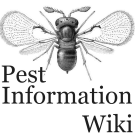Publications for:
pest = Meloidogyne incognita
country = Japan
found 23 publications:2020
Root-knot nematode genetic diversity associated with host compatibility to sweetpotato cultivarsMolecular Plant Pathology (2020) 21 (8), 1088-1098
publishers website - pestinfo wiki
Solanum palinacanthum: broad-spectrum resistance to root-knot nematodes (Meloidogyne spp.)
Pest Management Science (2020) 76 (12), 3945-3953
publishers website - pestinfo wiki
2018
Effects of high grafting on tomato plants infected by Meloidogyne incognita and Ralstonia solanacearumJournal of Phytopathology (2018) 166 (1), 53-58
publishers website - pestinfo wiki
Suppressive effect of black oat, Avena strigosa, KH1a on Meloidogyne spp.
Nematology (2018) 20 (4), 387-396
publishers website - pestinfo wiki
2017
Review of major sweetpotato pests in Japan, with information on resistance breeding programsBreeding Science (2017) 67 (2),73-82
publishers website - pestinfo wiki
Differences in parasitism of Meloidogyne incognita and two genotypes of M. arenaria on Solanum torvum in Japan
Journal of Phytopathology (2017) 165 (9), 575-579
publishers website - pestinfo wiki
2015
Influence of nematicide on the damage caused by Meloidogyne incognita (Tylenchida: Meloidogynidae) to sweet potato in sandy fields in northeastern Tokushima PrefectureApplied Entomology and Zoology (2015) 50 (2), 255-261
publishers website - pestinfo wiki
Simultaneous detection and discrimination of Pratylenchus and Meloidogyne species in Japanese fields using group-specific primers and denaturing gradient gel electrophoresis
Journal of General Plant Pathology (2015) 81 (2), 151-161
publishers website - pestinfo wiki
2014
The feeding behavior of adult root-knot nematodes (Meloidogyne incognita) in rose balsam and tomatoJournal of Nematology (2014) 46 (3), 296-301
publishers website - pestinfo wiki
2012
Development of AFLP-derived SCAR markers associated with resistance to two races of southern root-knot nematode in sweetpotatoEuphytica (2012) 188 (2), 175-185
publishers website - pestinfo wiki
Plant regeneration from Crotalaria spectabilis hairy roots which showed inhibited growth of root-knot nematodes (Meloidogyne hapla and M. incognita) in vitro
Plant Biotechnology (2012) 29 (5), 425-430
publishers website - pestinfo wiki
2011
Development of a direct quantitative detection method for Meloidogyne incognita in sandy soils and its application to sweet potato cultivated fields in Tokushima prefecture, JapanNematology (2011) 13 (1), 95-102
publishers website - pestinfo wiki
A multiplex real-time PCR assay for the simultaneous quantification of the major plant-parasitic nematodes in Japan
Nematology (2011) 13 (6), 713-720
publishers website - pestinfo wiki
2006
Resistance to two races of Meloidogyne incognita and resistance mechanism in diploid Ipomoea trifidaBreeding Science (2006) 56 (1), 81-83
publishers website - pestinfo wiki
Control mechanism associated with rice bran-amended soil for root-knot nematode, Meloidogyne incognita
International Journal of Nematology (2006) 16 (2), 126-133
pestinfo wiki
[Control of the southern root-knot nematode, Meloidogyne incognita using granule formulations containing nematode-trapping fungus, Monacrosporium ellipsosporum and a nematicide]
Japanese Journal of Applied Entomology and Zoology (2006) 50 (2), 115-122
publishers website - pestinfo wiki
2003
Influence of soil conditions, spore densities and nematode age on Pasteuria penetrans attachment to Meloidogyne incognitaSpanish Journal of Agricultural Research (2003) 1 (4), 57-63
publishers website - pestinfo wiki
2002
Combined application of Glomus sp. and Pasteuria penetrans for reducing Meloidogyne incognita (Tylenchida: Meloidogynidae) populations and improving tomato growthApplied Entomology and Zoology (2002) 37 (1), 61-67
publishers website - pestinfo wiki
2000
Studies on the interaction and Pasteuria penetrans and Glomus sp. as bio-management agents against Meloidogyne incognita on tomatoNematology (2000) 2 (7), p. 791
pestinfo wiki
1999
Identification of three major Meloidogyne species by stained spores of host-specific Pasteuria penetrans isolatesApplied Entomology and Zoology (1999) 34 (2), 195-203
pestinfo wiki
1998
Identification of Japanese species of the genus Meloidogyne (Nematoda : Meloidogynidae) by PCR-RFLP analysisApplied Entomology and Zoology (1998) 33 (1), 43-51
pestinfo wiki
1997
Effect of spore sonication on attachment and host-attachment range of Pasteuria penetrans to the root-knot nematodeApplied Entomology and Zoology (1997) 32 (1), 101-107
pestinfo wiki
1996
Geographical distribution of Meloidogyne species (Nematoda: Tylenchida) in tobacco fields of JapanApplied Entomology and Zoology (1996) 31 (2), 225-231
pestinfo wiki
